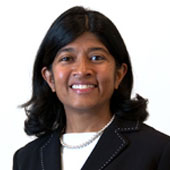Dateline India: What Shade of Brown Are You?
Why, in a country where everyone is various pigments of brown, are many Indians so eager to be anything but?
June 10, 2010
I myself would have never figured out the many shades of brown were it not for my colossal failure (at the tender age of 23) to procure a prospective husband in the Indian marriage market.
Born to Indian parents (who had a "love marriage") and raised abroad for most of my life should have been enough to earn an exemption from an arranged marriage.
But, truth be told, after a few failed relationships on my own, I thought to myself, "What more do I have left to lose?" And so I took the plunge and allowed my aunts to begin the process of "shopping" for a suitable groom.
Although now happily married, I ultimately failed in my assigned mission to find a husband in India. It took me a while to understand that a vital part of my failure in India itself was due to the fact that I didn't take the appropriate care to define the right shade of brown for myself.
I know now that "honey" is really a much better way to describe one's complexion and skin tone — and therefore, increase the pool of available suitors. It is definitely preferable to "wheat" or "coffee" — which denote a slightly darker shade of brown.
And if, as a prospective bride, you want to keep your potential future groom guessing, describe yourself as "café au lait" (the pool of French-speaking Indians is, after all, somewhat limited).
But whatever you do, heaven forbid that you should ever use the word "tan." True, to the untrained eye, this shade of brown might actually suggest that the bride-to-be relishes being in the sun.
Alas, in India, it connotes nothing but shame. How ironic that Northern Europeans, by contrast, long for that sunshine and delight in being tanned, while we South Asian women, surrounded by the sun's rays for most of the year, yearn to stay out of the sun.
If I had to do it over again, perhaps I would have used the terms "auburn" or "bronze" which denote something more glorious (and remind me of a walk down the hair-dye aisle of CVS — the drugstore chain here in the United States).
Why, in a country where everyone is, after all, various pigments of brown, are we so eager to be anything but?
As a child, I remember my grandmother rubbing malai — the cream that forms on top of milk — on my face, muttering to herself that only home remedies could help lighten my skin and then maybe I would find a suitable husband.
As I got older, the home remedies were replaced by India's best-selling cosmetic product, "Fair and Lovely" skin whitening cream, guaranteed to whiten your skin in 90 days.
It begged the broader question — could you be "lovely" without being "fair"? What color of brown was the closest to "fair"? And, was it "fair" that, in fact, brown couldn't be a color unto itself, but had to be marketed as something else?
As I tried to describe the closest shade of brown to my own skin, while I was in India during my 24th birthday and actively hunting for my future mate, I remembered getting ready for a college trip to Spain four years earlier.
There, a friend told me, "They'll call you morena (brown). It's a real compliment — and they'll love your skin." I remember at the time thinking that being brown was wonderful. And when I went to Spain, I blushed each time I heard the term morena.
Meanwhile back in India, during my spousal search, I decided to put down "chocolate" when the matrimonial section in the newspaper asked me to fill in the blank for skin complexion.
If only I had known then that "chocolate" was a code word for the darkest (and therefore least desirable) shade of brown — and hence the descriptor least likely to bring me my winsome groom.
If only someone had told me early on what shade of brown I should be, I would never have had to think about it as hard.
Takeaways
As a child, I remember my grandmother rubbing <i>malai</i> on my face, muttering to herself that only home remedies could help lighten my skin.
As I got older, the home remedies were replaced by India's best-selling cosmetic product, "Fair and Lovely" skin whitening cream.
Was it "fair" that, in fact, brown couldn't be a color unto itself, but had to be marketed as something else?
During my spousal search in India, I decided to put down "chocolate" when the matrimonial section in the newspaper asked to fill in the blank for skin complexion.
Read previous
Drones: Backfiring on U.S. Strategy
June 9, 2010
